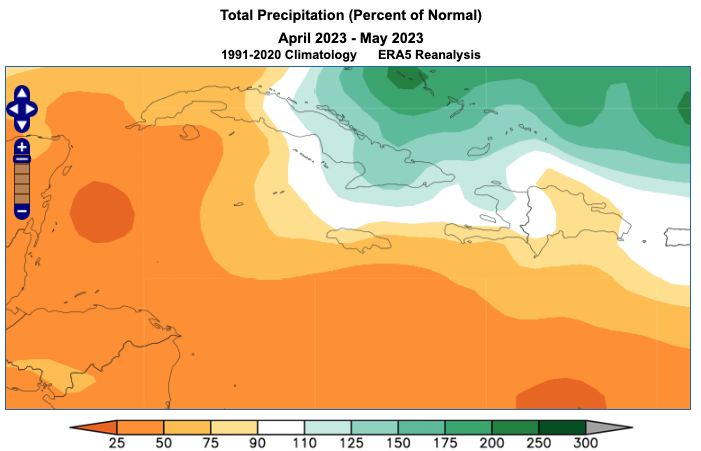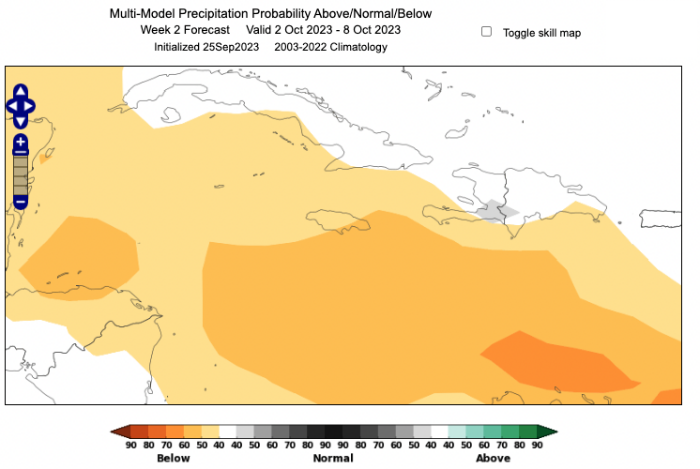A Jamaican Early Warning System:
The World Climate Service
The User: Meteorological Service of Jamaica
Jamaica experienced a drier-than-normal season heading into Spring 2023. This motivated the portfolio Minister in Jamaica’s Ministry of Economic Growth and Job Creation to determine whether he should initiate drought mitigation actions. The Minister turned to Evan Thompson, Director of the Meteorological Service of Jamaica (MSJ) and Jacqueline Spence-Hemmings, the MSJ Climate Branch Head. “Given the time of year, this was a critical subseasonal to seasonal (S2S) timescale forecast, and we needed to understand the chances of different outcomes.” Jacqueline Spence-Hemmings said. She continued, “While there are many sources of S2S forecast information, it’s scattered all over the web and not necessarily prepared consistently. I didn’t have much time to prepare our briefing, so I wanted to obtain as much valuable information as possible in one application.”

The Early Warning System: The World Climate Service
Jacqueline Spence-Hemmings contacted the folks at the World Climate Service, having met them earlier in the year at a Kingston, Jamaica, weather and climate conference. The information provided by the World Climate Service web portal was the critical information source for preparing their S2S forecast briefings.
The information included:
1) Calibrated, probabilistic subseasonal forecasts from the European Center for Medium-Range Weather Forecasting (ECMWF), National Oceanic and Atmospheric Administration’s (NOAA) Global Ensemble Forecast System, and Climate Forecasting System
2) Calibrated probabilistic seasonal forecasts from the ECMWF, NOAA, and the wide range of forecasts from data originating from Europe’s Copernicus project.
3) Analog analysis and forecasts to complement the dynamical forecast information.
4) Forecasts of both seasonal and subseasonal climate indices such as the El Niño/Southern Oscillation and the Atlantic Multi-decadal oscillation.
5) Historical climate data in an easy-to-use ECMWF Reanalysis v5 data viewer

The World Climate Service served as a Jamaican drought early warning system to help the government understand if it should implement drought mitigation efforts. The S2S forecast information allowed the Jamaican Meteorological Service to provide the probabilistic forecast context, weighing the likelihood of different outcomes.
“There are various sources of information available to enable long-range forecasts,“ says Evan Thompson. “And yet, making sense of all that data is enabled with a common framework to post-process both dynamical model and observational data sets. The World Climate Service not only improved our understanding of the risks implied by the forecasts, but we also got the benefit of the sub-seasonal timescale that the portal provides in its web-based location.”
The Future: Mitigating Climate Risk
Our changing climate is increasing climate variability, which increases the risks of dangerous and disruptive weather and climate conditions having material and even deadly impacts on businesses, countries, and governments. National meteorological services worldwide seek pre-existing, ready-to-use S2S forecasting systems to improve their early warning system capacity. The Jamaican Meteorological Service plans to continue to use the World Climate Service for the foreseeable future to ensure its government is prepared for the climate risks that will inevitably impact the island nation.
What to do next?
Contact info@worldclimateservice.com to request more information about the World Climate Service. Or visit https://www.worldclimateservice.com.